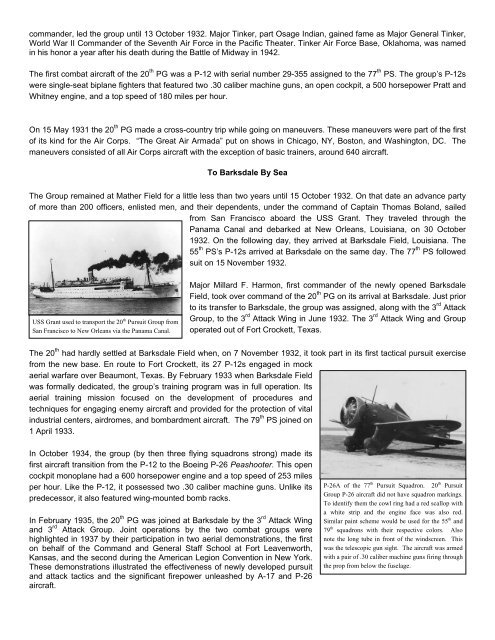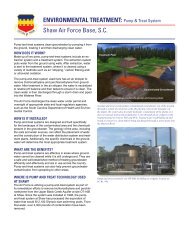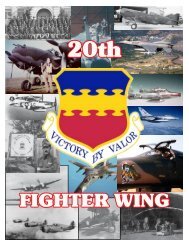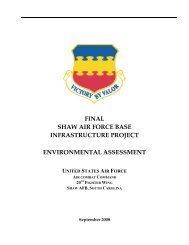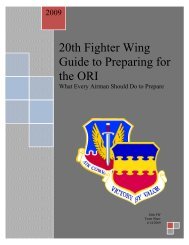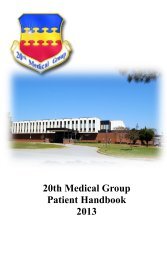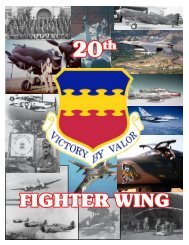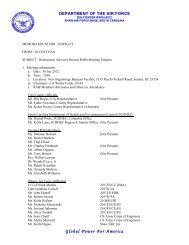HISTORY OF THE 20 FIGHTER GROUP - Shaw Air Force Base
HISTORY OF THE 20 FIGHTER GROUP - Shaw Air Force Base
HISTORY OF THE 20 FIGHTER GROUP - Shaw Air Force Base
Create successful ePaper yourself
Turn your PDF publications into a flip-book with our unique Google optimized e-Paper software.
commander, led the group until 13 October 1932. Major Tinker, part Osage Indian, gained fame as Major General Tinker,<br />
World War II Commander of the Seventh <strong>Air</strong> <strong>Force</strong> in the Pacific Theater. Tinker <strong>Air</strong> <strong>Force</strong> <strong>Base</strong>, Oklahoma, was named<br />
in his honor a year after his death during the Battle of Midway in 1942.<br />
The first combat aircraft of the <strong>20</strong> th PG was a P-12 with serial number 29-355 assigned to the 77 th PS. The group’s P-12s<br />
were single-seat biplane fighters that featured two .30 caliber machine guns, an open cockpit, a 500 horsepower Pratt and<br />
Whitney engine, and a top speed of 180 miles per hour.<br />
On 15 May 1931 the <strong>20</strong> th PG made a cross-country trip while going on maneuvers. These maneuvers were part of the first<br />
of its kind for the <strong>Air</strong> Corps. “The Great <strong>Air</strong> Armada” put on shows in Chicago, NY, Boston, and Washington, DC. The<br />
maneuvers consisted of all <strong>Air</strong> Corps aircraft with the exception of basic trainers, around 640 aircraft.<br />
To Barksdale By Sea<br />
The Group remained at Mather Field for a little less than two years until 15 October 1932. On that date an advance party<br />
of more than <strong>20</strong>0 officers, enlisted men, and their dependents, under the command of Captain Thomas Boland, sailed<br />
from San Francisco aboard the USS Grant. They traveled through the<br />
Panama Canal and debarked at New Orleans, Louisiana, on 30 October<br />
1932. On the following day, they arrived at Barksdale Field, Louisiana. The<br />
55 th PS’s P-12s arrived at Barksdale on the same day. The 77 th PS followed<br />
suit on 15 November 1932.<br />
USS Grant used to transport the <strong>20</strong> th Pursuit Group from<br />
San Francisco to New Orleans via the Panama Canal.<br />
Major Millard F. Harmon, first commander of the newly opened Barksdale<br />
Field, took over command of the <strong>20</strong> th PG on its arrival at Barksdale. Just prior<br />
to its transfer to Barksdale, the group was assigned, along with the 3 rd Attack<br />
Group, to the 3 rd Attack Wing in June 1932. The 3 rd Attack Wing and Group<br />
operated out of Fort Crockett, Texas.<br />
The <strong>20</strong> th had hardly settled at Barksdale Field when, on 7 November 1932, it took part in its first tactical pursuit exercise<br />
from the new base. En route to Fort Crockett, its 27 P-12s engaged in mock<br />
aerial warfare over Beaumont, Texas. By February 1933 when Barksdale Field<br />
was formally dedicated, the group’s training program was in full operation. Its<br />
aerial training mission focused on the development of procedures and<br />
techniques for engaging enemy aircraft and provided for the protection of vital<br />
industrial centers, airdromes, and bombardment aircraft. The 79 th PS joined on<br />
1 April 1933.<br />
In October 1934, the group (by then three flying squadrons strong) made its<br />
first aircraft transition from the P-12 to the Boeing P-26 Peashooter. This open<br />
cockpit monoplane had a 600 horsepower engine and a top speed of 253 miles<br />
per hour. Like the P-12, it possessed two .30 caliber machine guns. Unlike its<br />
predecessor, it also featured wing-mounted bomb racks.<br />
In February 1935, the <strong>20</strong> th PG was joined at Barksdale by the 3 rd Attack Wing<br />
and 3 rd Attack Group. Joint operations by the two combat groups were<br />
highlighted in 1937 by their participation in two aerial demonstrations, the first<br />
on behalf of the Command and General Staff School at Fort Leavenworth,<br />
Kansas, and the second during the American Legion Convention in New York.<br />
These demonstrations illustrated the effectiveness of newly developed pursuit<br />
and attack tactics and the significant firepower unleashed by A-17 and P-26<br />
aircraft.<br />
P-26A of the 77 th Pursuit Squadron. <strong>20</strong> th Pursuit<br />
Group P-26 aircraft did not have squadron markings.<br />
To identify them the cowl ring had a red scallop with<br />
a white strip and the engine face was also red.<br />
Similar paint scheme would be used for the 55 th and<br />
79 th squadrons with their respective colors. Also<br />
note the long tube in front of the windscreen. This<br />
was the telescopic gun sight. The aircraft was armed<br />
with a pair of .30 caliber machine guns firing through<br />
the prop from below the fuselage.


